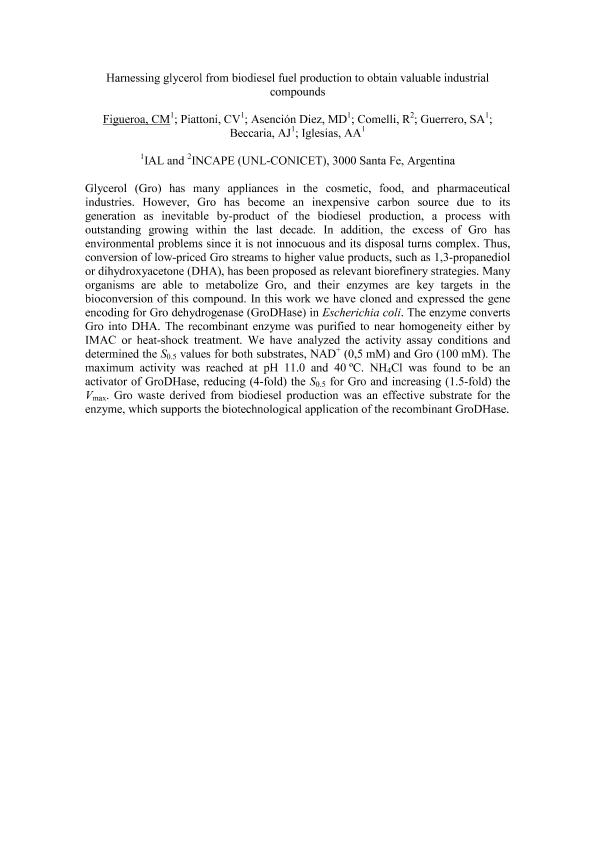Artículo
Harnessing glycerol from biodiesel fuel production to obtain valuable industrial compounds
Figueroa, Carlos Maria ; Piattoni, Claudia Vanesa
; Piattoni, Claudia Vanesa ; Asención Diez, Matías Damián
; Asención Diez, Matías Damián ; Comelli, Raul Alberto
; Comelli, Raul Alberto ; Guerrero, Sergio Adrian
; Guerrero, Sergio Adrian ; Beccaria, Alejandro José; Iglesias, Alberto Alvaro
; Beccaria, Alejandro José; Iglesias, Alberto Alvaro
 ; Piattoni, Claudia Vanesa
; Piattoni, Claudia Vanesa ; Asención Diez, Matías Damián
; Asención Diez, Matías Damián ; Comelli, Raul Alberto
; Comelli, Raul Alberto ; Guerrero, Sergio Adrian
; Guerrero, Sergio Adrian ; Beccaria, Alejandro José; Iglesias, Alberto Alvaro
; Beccaria, Alejandro José; Iglesias, Alberto Alvaro
Fecha de publicación:
10/2009
Editorial:
Instituto de Histología y Embriología
Revista:
Biocell
ISSN:
0327-9545
Idioma:
Inglés
Tipo de recurso:
Artículo publicado
Clasificación temática:
Resumen
Glycerol (Gro) has many appliances in the cosmetic, food, and pharmaceutical industries. However, Gro has become an inexpensive carbon source due to its generation as inevitable by-product of the biodiesel production, a process with outstanding growing within the last decade. In addition, the excess of Gro has environmental problems since it is not innocuous and its disposal turns complex. Thus, conversion of low-priced Gro streams to higher value products, such as 1,3-propanediol or dihydroxyacetone (DHA), has been proposed as relevant biorefinery strategies. Many organisms are able to metabolize Gro, and their enzymes are key targets in the bioconversion of this compound. In this work we have cloned and expressed the gene encoding for Gro dehydrogenase (GroDHase) in Escherichia coli. The enzyme converts Gro into DHA. The recombinant enzyme was purified to near homogeneity either by IMAC or heat-shock treatment. We have analyzed the activity assay conditions and determined the S0.5 values for both substrates, NAD+ (0,5 mM) and Gro (100 mM). The maximum activity was reached at pH 11.0 and 40 ºC. NH4Cl was found to be an activator of GroDHase, reducing (4-fold) the S0.5 for Gro and increasing (1.5-fold) the Vmax. Gro waste derived from biodiesel production was an effective substrate for the enzyme, which supports the biotechnological application of the recombinant GroDHase.
Palabras clave:
Glycerol
,
Dihydroxyacetone
,
1,3-Propanediol
,
Biorefineries
Archivos asociados
Licencia
Identificadores
Colecciones
Articulos(INCAPE)
Articulos de INST.DE INVEST.EN CATALISIS Y PETROQUIMICA "ING. JOSE MIGUEL PARERA"
Articulos de INST.DE INVEST.EN CATALISIS Y PETROQUIMICA "ING. JOSE MIGUEL PARERA"
Citación
Figueroa, Carlos Maria; Piattoni, Claudia Vanesa; Asención Diez, Matías Damián; Comelli, Raul Alberto; Guerrero, Sergio Adrian; et al.; Harnessing glycerol from biodiesel fuel production to obtain valuable industrial compounds; Instituto de Histología y Embriología; Biocell; 33; 10-2009; 55-55
Compartir



